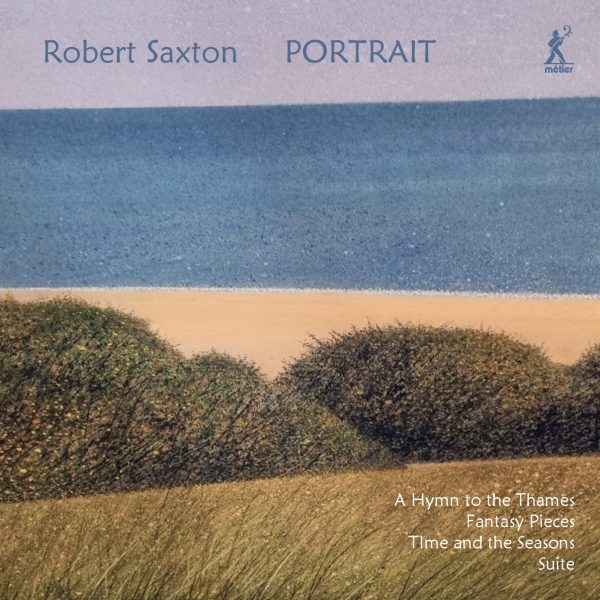American Record Guide
Robert Saxton (born 1953) is an English composer who studied with figures as varied as Robin Holloway and Luciano Berio. This album, titled “Portrait”, is a sampling of his more recent work, from 2013 to 2020. His music is tonal, but no one will doubt its modernity. Often approachable, it does ask for some headwork from the listener.
Hymn to the Thames is a four-segment work for oboe and orchestra. The oboe is both an observer of the river and the spirit of the river. Its themes use musical letter equivalents from the names of the river (B, A, E, Eb), as well as oboist John [sic] Turnbull and conductor Andrew Morley, who commissioned the piece. Its plan resembles a modern Moldau, each segment relating to the path of the river. The music begins with superimposed running figures of varying rhythms gradually forming the flowing waters. The solo part stretches the instrument in its upper range. In the third section, where the Thames flows through Oxford, the music quotes Thomas Tallis’s ‘ In Nomine’ and ‘ O Nata Lux.’ Saxton blends the quotations into the music with subtlety and skill. The oboe here moves more into its midrange. In the finale, the oboe rises as the orchestra sinks down to the depths as the Thames heads out to the sea.
Fantasy Pieces is a set of six short bits for violin, cello, and piano. I is a florid tribute to Schumann’s ‘Wild Horseman’ from his Album for the Young. II has a gradually descending melodic line. Ill is a fast dance with intermixed lines often clashing and percussive piano writing. In IV the theme plays over slow-moving harmonies. They coalesce into a unified section, blending into V. This has the strings in octaves over piano chords. The notes don’t mention this, but it often seems to quote the Credo from Beethoven’s Missa Solemnis. VI abruptly breaks in, the theme heard over turbulent tightly voiced piano chords. The work rises to an affirmative, if still mysterious close.
Time and the Seasons is a song cycle for baritone and piano. The composer’s texts, according to his notes, treat memory and time in the context of the passing seasons. They pay tribute to Scratchby on the Norfolk coast, where Saxton spent his childhood holidays. In the first, ‘Winter Still Winter’, the baritone sings the entire song on an A natural, while the piano part varies. A bold notion and an effective one. ‘ Spring’ has a more active vocal line. It becomes the more expressive in III, ‘Time’s Ellipse’. IV, ‘A Summer Psalm’ has an introspective piano solo. In V, ‘Autumn’, the singer is unaccompanied, tapering off to an effective ending. The last song, ‘The Beach in Winter,’ between the lines “Inward praise lifted me Towards the widened sky, There was no response” has a pause between a dramatic line to a static one after. The effect is gripping. There are recurring cross-references among the songs.
The Suite for violin and piano has brief movements. ‘Awakening’ at first seems unclear as to its goal but ends coherently. ‘Horizon’ has a slow violin melody with a probing accompaniment. It uses music from the earlier song cycle. The movement ends with a deeply descending piano part while the violin ascends to heights with harmonics. ‘ Jacob and the Angel’ was inspired by a Jacob Epstein sculpture, reflected in the strenuous rhythms of the players. In IV, ‘The Bells of Memory’, both players have prolonged lines, reinforced by the piano’s sustaining pedal. V, ‘ Quest,’ begins with a low piano line rising on a diatonic motif. The violin eventually merges, its phrases forming the “outreaching” conclusion.
Performances all sound capable and committed. The 36 players of the St Paul’s Sinfonia sometimes sound far more numerous and play with excellent ensemble. The chamber pieces are done with fervor, their momentum helped by accurate, aggressive attacks with good phrasing. In the song cycle, baritone Williams turns in his customary stellar rendition—for example, sustaining the single pitch in ‘Winter, Still Winter’ for three minutes. Recorded sound is good, a bit more closely miked for the chamber works. Informative notes and texts by the composer.
@divineartrecordingsgroup
A First Inversion Company
Registered Office:
176-178 Pontefract Road, Cudworth, Barnsley S72 8BE
+44 1226 596703
Fort Worth, TX 76110
+1.682.233.4978












